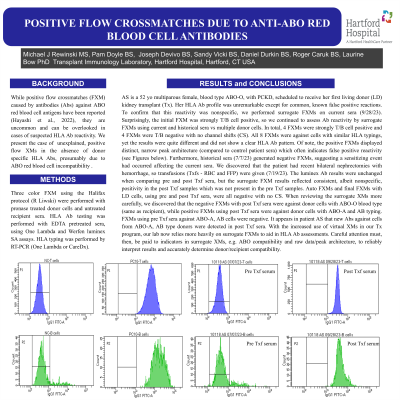Back

POSITIVE FLOW CROSSMATCHES DUE TO ANTI-ABO RED BLOOD CELL ANTIBODIES
(P513) Positive flow crossmatches due to anti-abo red blood cell antibodies
Location: Platinum Ballroom

- PD
Poster Presenter(s)
Body: AS is a 52 yo multiparous female, blood type ABO-O, with PCKD, scheduled to receive her first living donor (LD) kidney transplant (Tx). Her HLA antibody (Ab) profile was unremarkable except for common false positive reactions. To confirm that this reactivity was nonspecific, we performed surrogate flow crossmatches (XM) on current sera (10/10/23). Surprisingly, the XM was strongly T/B cell positive so we continued to assess Ab reactivity by surrogate XMs using current and historical sera vs multiple donor cells. In total, 4 XMs were strongly T/B cell positive and 4 XMs were T/B negative with no channel shifts (CS). All 8 XMs were against cells with similar HLA typings, yet the results were quite different and did not show a clear HLA Ab pattern. Of note, the positive XMs displayed distinct, narrow peak architecture (compared to control patient sera) which often indicates false positive reactivity. Furthermore, the negative XMs resulted from historical sera (7/7/23), suggesting a sensitizing event had occurred affecting the current sera. We discovered that the patient had recent bilateral nephrectomies with hemorrhage, so transfusions (Txf - RBC and FFP) were given (7/19/23). The luminex Ab results were unchanged when comparing pre and post Txf sera, but the surrogate XM results reflected consistent, albeit nonspecific, positivity in the post Txf samples not present in the pre Txf samples. Auto XMs and final XMs with LD cells, using pre and post Txf sera, were all negative with no CS. When reviewing the surrogate XMs more carefully, it was discovered that the negative XMs with post Txf sera were against donor cells with ABO-O blood type (same as recipient), while positive XMs using post Txf sera were against donor cells with ABO-A and AB typing. XMs using pre Txf sera against ABO-A, AB cells were negative.
Conclusion: While positive flow XMs caused by Abs against ABO antigens have been reported, it is uncommon and can be overlooked in cases of suspected HLA Ab reactivity. It appears in patient AS that new Abs against ABO-A, AB cells are detected in post Txf sera. With the increased use of virtual XM in our Tx program, our lab now relies more heavily on surrogate XMs to aid in HLA Ab assessments. Careful attention must then be paid to indicators in surrogate XMs, e.g. ABO compatibility and raw data/peak architecture, to reliably interpret results and accurately determine donor/recipient compatibility.
Conclusion: While positive flow XMs caused by Abs against ABO antigens have been reported, it is uncommon and can be overlooked in cases of suspected HLA Ab reactivity. It appears in patient AS that new Abs against ABO-A, AB cells are detected in post Txf sera. With the increased use of virtual XM in our Tx program, our lab now relies more heavily on surrogate XMs to aid in HLA Ab assessments. Careful attention must then be paid to indicators in surrogate XMs, e.g. ABO compatibility and raw data/peak architecture, to reliably interpret results and accurately determine donor/recipient compatibility.
